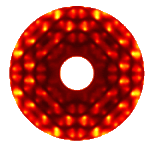Interactive example: HK plane simulator

Reciprocal space
Reciprocity
Square lattice
Rectangular lattice
Oblique lattice
Translation of lattice
Rotation lattice
Interactive examples
2D crystal builder
Planes and HKL's
Finite size effect
Goto
Contents
Start exploring and try to answer the question below:
- What is the relationship between the indices h,k and the position and orientation of the planes in direct space ?
- What is the effect of the hk indices on the distance between the planes ?
- How do the b/a ratio and the angle affect the hk planes?
- How do the rotation and the shifts affect the hk planes?
- Where is the Bragg reflection corresponding to the hk plane ?
- How do the b/a ratio and the angle affect the hk planes?
- How does rotating and shifting the complete structure affect the Bragg reflection ?
- What, if any, influence does the radiation have on the hk planes and the Bragg reflection ?
The program will draw the crystal structure in the left image, and the
corresponding diffraction pattern in the right image. All atoms will
be drawn in blue, except the atom at the origin of the unit cell which
is green. The unit cell is outlined in red. The corresponding unit
cell in reciprocal space is drawn in blue.
The hk planes in direct space are drawn as green lines. The thick green
line represents a vector normal to the planes. The corresponding
vector to the Bragg reflection is drawn in green as well.
Once you are done, click
here to verify your answers.